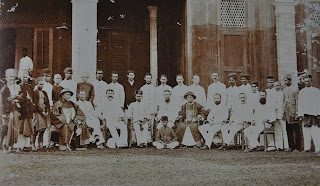The children at the overhead bridge, waiting to cross the road. They are in for lesson number 2.
Question: Who was Raja Laut?YTM Raja Laut ibni al-Marhum Sultan Muhammad Shah, born in Kuala Selangor in 1850. Penghulu and Magistrate Kuala Lumpur, member of the Kuala Lumpur Sanitary Board, Chairman of the Kampung Bahru Agricultural Settlement.
Appointed Raja Muda in 1899 but superseded in 1903. However, allowed to keep the title until his death in 1913. (Source: royalark.net)
When Sultan Muhammad died in 1857 without appointing an heir, Raja Laut, while being competent, was not able to succeed his father as he was the son of a concubine (Raja Asiah). (Source: http://yapahloy.
tripod.com/the_death_of_sultan_muhammad.htm)
Prominent residents of Kuala Lumpur, 1884
(from: MALAYSIA a pictorial history 1400-2004 by Wendy Khadijah Moore)
Raja Laut (cropped and enlarged)
The Chow Kit area is also home to vagrants and homeless people.A number of NGOs do operate food kitchens and other social services in the area. I think that this is becoming a vicious cycle - more people - more help, more help - more people....... but to paraphrase the words of the late Mother Theresa, 'do it anyway.'
Passing the Thakardas building. The National Library used to be located here before moving to its own premises at Jalan Tun Razak.
I never noticed it before, but there is a Gurdwara (Sikh prayer house) located in this building.
We now arrive at Tiong Nam Settlement.
In all my years of growing up here, I never once wondered about the origins of the name. I just assumed that it was the name of the developer or something. It is one of the earliest Chinese housing settlements in KL but it is now considered a slum according to this article.
According to the same article also the Chinese community refer to this as Tiong Nam Ku meaning the Middle South Area.
According to an interview with Mr. Ong Yoong Nyock, founder of Tiong Nam Logistics Holdings Bhd (I don't think there is a link between the company and the settlement, I was just looking for the meaning or origins of Tiong Nam) published in www.frost.com, he said that the name carries the meaning of East (Tiong) and South (Nam) in Hokkien.
Middle South or East South, either way it baffles me as the area would have been North or North West of KL Town Centre not the South East.
I only remember one Chinese Temple at Jalan Tiong Nam 5. Over the years, a number of residential houses have been converted into Temples. Posing for group photos in-front of the Temples. For most of the children, this was their first time visiting Chinese temples. Unfortunately, however, these were closed.





























No comments:
Post a Comment